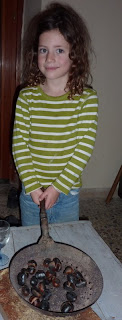I've been keen to make the most of my time in Italy to improve my Italian, and have therefore been taking every opportunity for conversation. I've already had more conversations than I would have thought possible about the relative merits of different types of wood for burning in open fires as compared to stoves. (You don't want anything which will explode or give off too much smoke in a fireplace, so apparently chestnut is out.) And I think the Jehovah's Witnesses who visited me last week were rather surprised when I eagerly bounded to the garden gate and started talking to them about the history of the treatment of the Jehovah's Witnesses during World War Two. Unfortunately, after a few minutes they made their excuses and left.

Anyway, another good topic of conversation is food. I first heard about these deep-fried tomatoes in my Italian class and was intrigued. Then this morning I saw some nice green salad tomatoes in the local shop and thought I'd give it a try. I had a long chat with the woman behind me in the queue about how thickly they should be cut, how runny the batter should be, and whether it is best made with sparkling water or with beer.
I'm not sure how easy it will be to get tomatoes like this in the UK. In Spain and Italy, green tomatoes like this are sold for salads, although people usually avoid the ones that are totally green. For this dish, I think the greener the better.
Ingredients3 large, green tomatoes
2 eggs
1 cup of plain flour
cold sparkling water
2 teaspoons of salt
vegetable oil for deep frying
MethodSlice the tomatoes into thickish slices (a little less than 1 cm, I guess) and sprinkle with 1 teaspoon of salt
Make the batter by gently beating two eggs, then adding about a cup of plain flour, before thinning out with some cold sparkling water. (I know this is terribly vague. This is basically just a deep-frying batter. I don't measure these things - and neither should you!)
Heat plenty of oil in a deep-frying pan.
Coat the tomato slices in the batter, and fry in batches. The oil should not be too hot, or the batter will cook on the outside before the tomatoes are cooked on the inside.
Cook the slices for a couple of minutes, then turn over and cook for a further 2 minutes.
Remove to a plate, sprinkle with the 2nd teaspoon of salt and allow to cool for a couple of minutes or so before serving.
Frying tonightBagni di Lucca, where we are staying, is close to the town of Barga, in the Garfagnana region of Tuscany. Many of Scotland's Italian community have their origins here, and connections with the old country remain strong. Every summer, when Italo-Scottish chipshop owners and their families head to Barga for the summer, Barga holds a "fish and chip" festival. This is always viewed as a bit of an oddity, and there is an assumption in Scotland that the Barga locals must be appalled by what their expatriate cousins do for a living in Scotland. However, if this local recipe is anything to go by, then I doubt that anyone was particularly surprised. After all, if you will deep-fry a tomato, then why not do the same to fish and chips?











